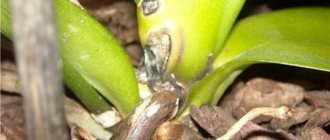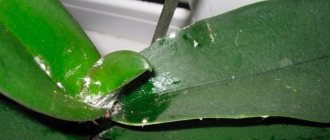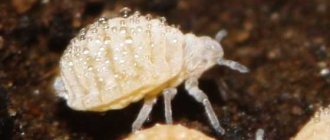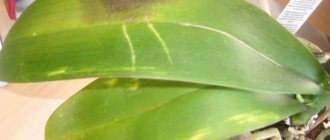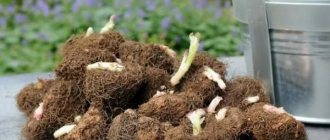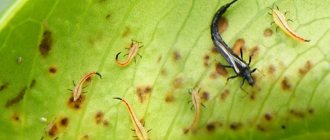Causes of appearance and what are the dangers?
The appearance of a mite on an orchid can be caused by several factors:
- presence in ready-made soil purchased in a store;
- planting a flower in an untreated container;
- hitting the windowsill through a window with a gust of wind;
- low level of air humidity;
- incorrect watering regime or insufficient frequency;
- oversaturation of the soil with minerals and other useful elements as a result of too frequent fertilizing.
Ticks also enter the room on human clothing.
Where do they come from?
This situation often occurs. The orchid felt great for a long time, when suddenly ticks appeared out of nowhere. There may be several reasons for infection:
- Microscopic arthropods fall onto plants with the wind from an open window. This is one of the reasons why it is better to place orchids away from drafts.
- If a new plant appears in the house, it may be infested with mites. To prevent the spread of pests, the newly acquired indoor flower is placed in quarantine, that is, completely separately. It is monitored for at least two weeks, and only after this period, if no suspicious symptoms are found, is it added to the main collection. The recommendation applies not only to purchased plants, but also to those that you exchange with home gardening enthusiasts.
Mites may appear along with the new plant.
The source of pests can be a substrate with mite larvae. Under favorable conditions - low humidity, dry air, excessive feeding - mites actively develop and spread.
Whatever the reason for the appearance, treatment of an infected orchid is carried out using acaricides.
Varieties: what they look like from the photo
There are several types of mites that attack orchids, each of them has its own distinctive characteristics.
Red spiderweb on leaves
Tetranychus cinnabarinus. This type of arthropod pest is considered the most dangerous due to its increased resistance to insecticides. A female mite can lay 6 to 7 eggs per day, and up to 150 eggs per month. The most favorable environment for the reproduction of red spider mites is an excess of nitrogen in the soil. Its distinctive features are the yellow, orange or red color of the body.
Most often, the pest settles on the outside of the leaf.
Armored
Oribatida mites. Externally, the oribatid mite resembles a small dark pea. On average, its size is 0.8 mm. Color can vary from dark brown to brown and black. Adult parasites and larvae live in the soil and feed on its constituent components.
When there is a deficiency of nutrients, orchid mites infect orchid leaves. Phalaenopsis are especially susceptible to attacks from these arthropods. Ideal conditions for pests to reproduce are high soil moisture and lack of drying.
White cobweb or false
Tetranychus urticae. The false or white spider mite gets its name from the white web it produces. Due to its very small size (0.25-0.3 mm), it is almost impossible to see this pest. Its presence on an orchid can be detected by the presence of cobwebs.
In advanced cases, spider mites form large colonies, the color of which varies from green to red. From the first days of its appearance, this type of parasite begins to actively destroy the orchid.
Onion root
Rhizoglyphus echinopus. Externally, root mites resemble small spiders. Pests have three pairs of legs, an oval body and sharp antennae. Their main feature is their high endurance, which allows them to remain without food for a long time; their main diet is underground parts of the plant and organic remains.
The distinctive features of bulb mites are a large body (1-1.5 mm) with a cloudy, glassy color.
The parasites are quite prolific: one female lays up to 300 white oval eggs. Favorable living conditions for them are abundantly moist soil with excess fertilizer content. In the process of their life activity, these arthropods turn the orchid roots into dust, which leads to the death of the plant.
Flat-bodied
Tenuipalpidae. Flat-bodied mites are distinguished by their small size (up to 0.3 mm) and an oval, slightly flattened yellow-red body covered with miniature bristles. The presence of these pests can be detected only after the formation of colonies or by the affected plant fragments.
Optimal conditions for the appearance of mites on orchids
Spider mites prefer dry air and high temperatures, so they attack weakened plants kept in such conditions. They reproduce in closed ground when the thermometer is not lower than 12 degrees Celsius. About 20 generations are produced annually, the full development cycle of one generation lasts from 12 to 20 days, and it decreases with increasing air temperature. The optimal range is 28–32 degrees above zero with air humidity no more than 45–50%, when the complete transformation into an adult spider mite occurs in 6–6.5 days.
Signs of infection
The presence of a mite on an orchid can be determined by the following signs:
- the presence of whitish or small gray inclusions on the leaf plates;
- the formation of a silvery web on the back of the leaves;
- the appearance of brown spots (usually they are present on the axils of the leaves or at the base of the stem);
- drying of sheet plates along the edges with subsequent deformation;
- yellowing, curling and falling of leaves;
- the appearance of rot on the lower part of the stem (in the form of wet dark spots, which over time transform into depressions and holes);
- shortened peduncles, unusual for orchids.
When you press on the affected areas, a red-brown liquid appears.
Harm caused
These parasites use plant sap as a source of nutrients. When biting a leaf plate or stem, it releases a special secretion into the tissues, which destroys the cellular structure of the plant. This activates the juice separation. Air enters through the puncture. In the damaged area, a light coating first forms, then the surface becomes covered with cobwebs. Over time, the leaf turns yellow, dries out and falls off.
When there is a large colony of mites, cobwebs appear not only on the leaves, but also on the flowers. Then the foliage turns yellow, curls and falls off very quickly. The same thing happens with buds. They also dry out and crumble. If the plant is heavily infested with spider mites, it may die.
Important!
Another danger of spider mites is the increased risk of developing viral and fungal diseases. Therefore, often, along with signs of the presence of spider mites, dark or weeping spots are noticeable on the plant.
How to get rid of it: control measures
When the first signs of the presence of a mite on an orchid are detected, it is necessary to begin eliminating it without delay, since ignoring this problem will lead to the death of the affected plant and massive infection of other indoor crops.
Procedure:
- isolation of the affected specimen in a separate room;
- rinsing under running warm water;
- removing moisture from the sinuses and drying the plant.
If the white coating cannot be washed off with water, it is recommended to wipe the leaf blades with cotton swabs or pads soaked in water. To increase humidity, it is recommended to water the epiphyte, wrap it in plastic wrap and leave it in this form for no more than three days.
If oribatid mites are detected, several manipulations must be performed:
- remove the plant from the pot and clean it from the soil;
- dilute liquid laundry soap (1 tbsp/1 l) in warm water;
- soak the root system in the prepared solution and leave for 30 minutes, periodically shaking off mite eggs from the roots;
- repeat the soaking procedure 2-3 times, replacing the solution with a fresh one;
- remove damaged fragments;
- treat cut areas with activated carbon;
- plant the flower in clean soil.
After providing first aid to the orchid, it is necessary to begin its radical treatment.
Why might a plant be especially vulnerable?
As a rule, most parasites, including spider mites, enter the plant from open windows during ventilation, or with newly brought flowers.
Given the plant’s high demands on light and humidity, any imbalance can lead to rapid proliferation of the pest and death of the orchid. At the same time, the plant can “get sick” with other ailments (gray rot or viral infections), the occurrence of which is facilitated by the juice protruding onto the surface of the leaf at the puncture sites.
Treatment with folk remedies
The use of drugs prepared according to folk recipes allows you to get a positive result only with a slight spread of pests.
When using this method in the fight against spider mites, it is important to remember that the parasites can only be completely destroyed through chemical treatment.
The most effective folk remedies are:
- Garlic infusion (170 grams of garlic cloves are poured into 1 liter of water and infused for 5 days).
- Tincture of dandelion roots (to prepare the composition, 30 grams of roots are soaked in 1 liter of cold water).
- Decoction of citrus fruits (100 grams of citrus peels are poured with water, boiled and infused for three days).
- Onion tincture (15 grams of pulp is poured into 1 liter of water and left for 7 hours).
Advantages of folk remedies:
- availability;
- ease of preparation and use;
- environmental cleanliness.
Mistakes in caring for Orchids
- Root rot, manifested in plant lethargy, drooping leaves, softening of the root collar, can be caused by excessive watering, watering with cold water, planting plants too deeply, damage to the roots during transplantation, or incorrectly selected soil. To avoid this, compose the soil so that it dries completely in 2-3 days. Do not water orchids until the velamen lightens (dries out).
- Brown or brown dry spots on the leaves can be caused by sunburn, watering with hard water with chemical impurities, watering with cold water, or overfeeding fertilizers.
- Black or brown spots, small as dots or larger, round or irregular in shape, are caused by fungal or bacterial diseases, most often appearing as a result of poor air ventilation and high humidity.
- Lack of flowering - primarily can be caused by violations in the conditions of maintenance, for example, an incorrect dormant period, lack of lighting, too hot dry air in the room, etc., as well as when affected by diseases and pests, or due to improper transplanting or planting in an unsuitable soil mixture.
Chemicals: how to treat?
The main advantages of chemicals are as follows:
- providing effective protection against pests;
- ability to destroy large colonies;
- long-term effect (up to 2 weeks from the date of treatment).
The disadvantages include toxicity.
The most popular chemicals:
- Nissoran - contains the active component hexythiazox, highly effective in the fight against ticks at all stages of development. To treat the plant, 1 gram of powder is dissolved in 1 liter of water.
- Actellik - includes pirimiphosmethyl. To prepare a working solution, 1 ml of the drug is diluted with 1 liter of water. Treatment is performed 2 times with an interval of 10 days.
- Sunmite is a yellow-white powder containing pyridabene. Before use, it is diluted with water in a ratio of 1 g: 1 liter. Eliminates ticks at all stages of development.
- Anti -mite is an intestinal-contact toxic chemical that contains malathion. To prepare the solution, it is diluted with water in a ratio of 1 ml per 1 liter.
Biological agents
The advantage of biological agents is the ability to treat plants throughout the year and the inability to induce resistance in parasites. The disadvantage is that it is effective only at the initial stage of the lesion. The most common biological agents:
- Bona Forte - created on the basis of Dalmatian chamomile flowers. Allows you to get excellent results in the fight against all types of ticks.
- Akarin - contains the active ingredient avertin N, available in ampoules. Before use, dilute with water: 1 ml/1 liter.
- Fitoverm - available in the form of a concentrated suspension, contains the biopesticide aversectin C. Maintains a protective effect for 2 weeks from the date of treatment.
Prevention measures
The best prevention of the appearance and further proliferation of spider mites in the house is to humidify the air and the plant itself. From time to time, give your orchid a warm shower; in the summer, spray the leaves (if the plant is not “resting”) and the air around the flower. The main thing is to periodically inspect the plant and substrate. If a parasite is detected at an early stage, it is much easier to get rid of it and keep the flower healthy.
Similar articles
How to get rid of dangerous mealybugs on an orchid
How to quickly and permanently get rid of aphids on an orchid
How to get rid of skinny little bugs in an orchid
Proper care of phalaenopsis orchid at home

